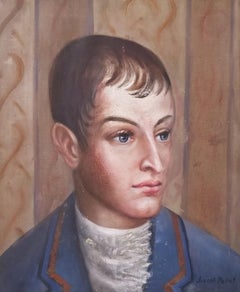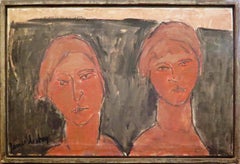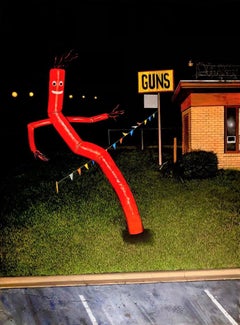Joseph Pollet Art
to
1
2
2
1
1
Overall Height
to
Overall Width
to
1
1
1
1
1
1
1
1
2
1
1
5
6,886
3,210
2,514
1,217
2
2
1
1
Artist: Joseph Pollet
Portrait
By Joseph Pollet
Located in Saratoga Springs, NY
Signed lower right.
Description
A portrait of a stylized young man dressed in a blue coat with a ruffled white shirt in an artistic background suggest that it may be a portrait of a young actor or performer.
About the artist.
Joseph Pollet was an important member of the Woodstock Art Colony. He emigrated to NYC in 1911 from Albbruck, Germany (born in 1897) and at age 21 had a promising career as an advertising copywriter. While working, he studied painting and his landscapes were immediately successful in NYC galleries. He studied at the Art Student's League with John Sloan, Robert Henri, and Homer Boss...
Category
1950s American Modern Joseph Pollet Art
Materials
Oil, Canvas
Woodstock Landscape
By Joseph Pollet
Located in Lawrence, NY
We are pleased to present this powerful work by German-American artist Joseph Pollet, 1929, with its profound prelapsarian message.
Pollet was a member of the Woodstock Artist Colon...
Category
1920s American Realist Joseph Pollet Art
Materials
Oil
Related Items
"Two Women"
By James Lechay
Located in Lambertville, NJ
James Lechay was a painter of figures, landscapes, cityscapes and still lifes who played a notable role in the tradition of avant-garde painting in New York and in the Midwest. An ar...
Category
20th Century American Modern Joseph Pollet Art
Materials
Canvas, Oil
Contemporary, Dark, American Oil Painting on Canvas
Located in Fort Worth, TX
GUN SALE is an oil on canvas painting standing at 54 inches tall and 41 inches wide, featuring an inflatable advertiser standing adjacent to a gunshop seated in a dark, night sky background.
A well-known figure of the contemporary Fort Worth art scene, Daniel Blagg...
Category
2010s American Realist Joseph Pollet Art
Materials
Canvas, Oil
Colorful and Blue American Contemporary Oil of Funny Sign Reading, "Drugs."
Located in Fort Worth, TX
Caduceus, 2011, Daniel Blagg, Oil on canvas, 80 x 60"
By meticulously depicting forgotten road signs and roadside debris, Daniel Blagg invites his viewe...
Category
2010s American Realist Joseph Pollet Art
Materials
Oil, Canvas, Acrylic
H 80 in W 60 in D 2.5 in
New Hampshire A beautiful landscape of a house similar to Fairfield Porter
By Stan Brodsky
Located in Brookville, NY
These earlier works by Stan Brodsky are reminiscent of Fairfield Porter. Stan Brodsky found his path into painting through the landscape. In his paintings of the 1970's, the horizo...
Category
Late 20th Century American Realist Joseph Pollet Art
Materials
Oil
The Artist's Wife oil painting by Hans Burkhardt
By Hans Burkhardt
Located in Hudson, NY
Hans Burkhardt
The Artist's Wife (1930)
Oil on canvas, 20" x 16"
24" x 20 ½" x 1 ½" framed
Dated 1930 lower right recto. Annotated "To Elsa HB Louise Burkhardt 1930. HB" verso.
...
Category
1930s American Modern Joseph Pollet Art
Materials
Oil, Canvas
Late Day
Located in Saugatuck, MI
In "Late Day" John Dowd brilliantly captures a beautiful sunset near Provincetown Massachusetts. Please note that framed dimensions are 13" x 17".
Category
21st Century and Contemporary American Realist Joseph Pollet Art
Materials
Oil
Riders of Pigeon Hill
By Jon Corbino
Located in Los Angeles, CA
Riders of Pigeon Hill, c. 1940s, oil on canvas, signed lower right, 24 x 36 inches, label verso with title, artist’s name and address; same information inscribed verso; ex-collection...
Category
1940s American Modern Joseph Pollet Art
Materials
Canvas, Oil
The Demogogue
Located in Los Angeles, CA
The Demagogue or Tale in a Tub, 1952, oil on canvas, 20 x 24 inches, signed, titled, and dated verso
About the Painting
The Demagogue is an iconic Bendor Mark painting from the prime of his post-war period. Beginning early in his career, Mark was fascinated with depictions of the human figure and their capacity to tell stories of the world around him. Mark was a keen observer of his times and in The Demagogue we see Mark’s portrayal of a faithless politician holding up a “V” for victory sign as he appeals to the wanton desires and prejudices of the masses. Below the demagogue is a swirl of humanity representing the common man who is being pushed down by the powerful, while the robed figure of liberty with her scales of justice held high is brushed aside. Behind the demagogue, Mark places two other powerful supporting institutions which were often co-opted by the world’s dictators, the Church and the Military. Mark was an internationalist, so it is difficult to know exactly which demagogue inspired him to create this work, but in 1952 there were many to choose from. Whether depicting Argentina’s Peron (the demagogue and the women to the right resemble Juan and Eva Peron), Spain’s Franco or the United States’ homegrown fear mongers like Joseph McCarthy, Mark tells a universal story that unfolded in dramatic fashion during the post-war period as nations and their peoples grappled with authoritarianism and anti-democratic impulses. Stylistically, The Demagogue draws on the elements which make Mark’s work from this period immediately recognizable, a saturated palette, a closely packed and frenetic composition, exaggerated figuration and stylized facial features. But, above all, we see Mark’s ability to tell the stories of the rich and powerful and their ability to oppress. Like Mark’s work in the collection of the Whitney Museum of American Art (The Hourglass - 1950-51) and the Los Angeles County Museum of Art (Execution – 1940), The Demagogue pulls no punches, as the artist lays bare the threats to freedom and basic human rights.
About the Artist
Bendor Mark was an American modernist and social realist painter. Born as Bernard Marcus on June 5, 1912, in Brooklyn, New York, Mark trained at The Cooper Union during the 1920s where he studied with William Brantley van Ingen and became a prize-winning artist with a focus on painting the human figure. After his time at Cooper, Mark continued to live in New York and worked as a commercial artist and textile designer in addition to his pursuit of a career in painting. Like many Depression Era artists, Mark engaged with social progressives and in 1934, he joined the Artist’s Union which had the goal of advancing artists’ position as “worker.” Mark’s painting, Restaurant, which is now in the permanent collection of the Smithsonian American Art Museum, appeared in the February 1936 edition of the Union’s publication, Art Front, as part of a review of an exhibition at ACA Gallery in New York.
Mark worked on the Federal Art Project and by the mid- to late-1930s, began a series of paintings exploring the working conditions and hazards of the mining industry. Mark believed that miners were “in the forefront of the struggle for emancipation” and that the mere “struggle for existence is like moving mountains.” He became passionate about the Spanish Civil War and painted sympathetic images in support of the Spanish Republic. Mark was a premature anti-fascist and throughout his career painted works critical of dictators and other oppressors. During the late 1930s, Mark entered mural competitions with designs influenced by the Mexican muralists, taught adult art education in Queens, New York, and was an instructor at the WPA’s Queensboro Art Center. He was so committed to socially progressive art that by 1934, he had changed his name to Bendor Mark, in part, to distinguish his social realist paintings from his earlier work.
During World War II, Mark worked as an artist for military contractors. After the war, he was employed as a graphic artist and in the printing industry before moving to Southern California in 1948, where he returned to a fine art practice the following year with politically and socially charged images which reflected his view of the shortcomings of the post-War period, the continued threat of fascism, and the international tensions of the Cold War. As the mood of the country shifted towards the right during the McCarthy Era and the art world’s attention focused on abstraction at the expense of figuration, Mark’s career as a painter suffered.
From the 1950s through the 1980s, Mark continued to depict the events that shaped the world around him, often employing a highly stylized approach characterized by dynamic multi-figure compositions, a subtle muted palette, and exaggerated expressive features. A review of Mark’s oeuvre suggests that few people escaped Mark’s attention. He painted presidents, prime ministers, royalty, evangelists, musicians, and dictators (and their henchman), along with miners, farm workers, the urban poor, protesters, the unemployed and dispossessed. He laid bare the arrogance, cruelty, and hypocrisy of the world’s elites. Mark noted, “A work of art cannot be fully appreciated or wholly understood without considering the socio-political and cultural ambience that gave it birth.” He continued, “I have the ability to foresee the direction of social and political events while they are actually taking place.” He was not himself a direct political activist, however. Although Mark commented, “It’s a misconception to separate art from the social aspect of life,” he viewed artists as being neutral. According to Mark, “An apolitical attitude reflects the fact that the artist is passive. . . An artist never affects society; he merely reflects it.”
In addition to the Mexican Muralists, Mark was influenced by the old masters Rembrandt, Michelangelo, and Masaccio, as well as the more modern master, Van Gogh. Mark’s writings directly acknowledge these influences and archival material from his estate includes magazine articles, pamphlets and transparencies related to these artists. Mark also collected materials related to several of his social realist contemporaries, including Reginald Marsh, Ben Shahn, Leonard Baskin, and Raphael Soyer, who was Mark’s good friend. For years, Soyer sent Mark holiday cards and Soyer inscribed a message of friendship on a self-portrait he gifted to Mark in the 1970s, all of which are still held in the collection of Mark’s family.
From the late 1920s through the mid-1950s, Mark’s work was well received. His paintings won prizes and were accepted into major juried exhibitions including at the Brooklyn Museum, the New York World’s Fair and the Metropolitan Museum of Art. He gained national recognition for paintings depicting the oppressed and the common worker. Despite the decline in popularity of representational art during the 1950s and 1960s, Mark stayed true to his interest in depicting the human figure and by the last two decades of his life, his work underwent a reassessment as curators included Mark’s paintings in exhibitions showcasing the role of labor in art during the Depression Era. This recognition continued in recent years when Mark was honored by having his work included in the Whitney Museum of American Art’s ground-breaking exhibition, Vida Americana, which explored the pioneering role that the Mexican muralists played in the development of modern American art during the inter-war period. The influence of Rivera, Siqueiros and Orozco on Mark is unmistakable and his paintings from the 1950s (and beyond) sit comfortably in dialogue with other Los Angeles artists who continued to paint in the social realist tradition long after the mainstream art world had moved toward abstraction. Mark’s concern for underserved Brown and Black communities was shared with artists such as Charles White and his ally, Edward Biberman...
Category
Mid-20th Century American Modern Joseph Pollet Art
Materials
Oil, Canvas
“Girl in the Grass”
By Anton Refregier
Located in Southampton, NY
Original oil on canvas painting by Anton Refregier of a young girl resting in the grass. Signed upper right and dated 1962. Condition is very good. The painting is in its original oa...
Category
1960s American Modern Joseph Pollet Art
Materials
Oil, Canvas
Queen of the Night, narrative, partial nude figure, red colors, ethnic fabrics
By Audrey Anastasi
Located in Brooklyn, NY
ABOUT the artist:
Audrey Frank Anastasi is a prolific feminist artist, working in painting, drawing, collage, mixed media, & printmaking. She is also curator, gallerist, educator and arts advocate. Most of Ms. Anastasi's figurative works are painted with her non-dominant left hand. She has created large bodies of works of birds, animals and birch trees.
She has had 20 solo & 200 group shows. Her "ref-u-gee" series will be shown in 2020 at Medgar Evers College in collaboration with the Valentine Museum of Art, Brooklyn. Accompanying the show will be a limited-edition monograph w/ over 180 images and a foreword by Phyllis Braff. Ms. Anastasi's collage series was exhibited at Welancora Gallery, Brooklyn, in May, 2019. In 2018, ten paintings were exhibited in "Painting to Survive," curated by Yale critic Jonathan Weinberg.
Book and catalog publications include "Stations of the Cross", SPQR press, BREUCKELEN magazine, “Audrey Frank Anastasi”, catalog essay Cindy Nemser, and "Collage," essay by Giancarlo T. Roma.
Public art includes a portrait of Jo Davidson...
Category
2010s American Modern Joseph Pollet Art
Materials
Oil, Canvas
mr. c and gladys, bright colorful man and dog
By Stephen Basso
Located in Brooklyn, NY
*ABOUT Stephen Basso
Stephen Basso's highly original pastels and oil paintings are romantic, yet thought provoking fantasies. His whimsical works are alive with boundless imagina...
Category
2010s American Modern Joseph Pollet Art
Materials
Canvas, Oil
Farm Mural Study
Located in Los Angeles, CA
This painting is part of our exhibition America Coast to Coast: Artists of the 1930s
Farm Mural Study, c. 1940, oil on Masonite, signed lower right, 15 x 42 inches; presented in a newer wood frame
About the Painting
A delightful regionalist composition, Cecil Head’s Farm Mural Study features a tidy and verdant farmscape where the animals outnumber the farmer and remind the viewer of an idealized fecundity of the American Midwest. Head gained early recognition for his mural designs in 1934 when his work was selected to represent Indiana in a Public Works of Art Project exhibition at the Corcoran Gallery of Art in Washington DC. Head excelled at rural Indiana scenes and the present work bears comparison to his most famous painting, Potato Planters, a 1936 work, which won first prize at the Hoosier Salon and was exhibited at the Carnegie Institute in 1941. Both works feature hard-working farmers in straw hats standing against the back drop of farm buildings. A critic's commentary about Potato Planters also applies to Farm Mural Study, "the various farm objects...
Category
1940s American Realist Joseph Pollet Art
Materials
Oil
Joseph Pollet art for sale on 1stDibs.
Find a wide variety of authentic Joseph Pollet art available for sale on 1stDibs. You can also browse by medium to find art by Joseph Pollet in oil paint, paint, canvas and more. Much of the original work by this artist or collective was created during the 20th century and is mostly associated with the modern style. Not every interior allows for large Joseph Pollet art, so small editions measuring 21 inches across are available. Customers who are interested in this artist might also find the work of Cecil Crosley Bell, Harold Vincent Skene, and Edwin Georgi. Joseph Pollet art prices can differ depending upon medium, time period and other attributes. On 1stDibs, the price for these items starts at $6,000 and tops out at $9,500, while the average work can sell for $7,750.



